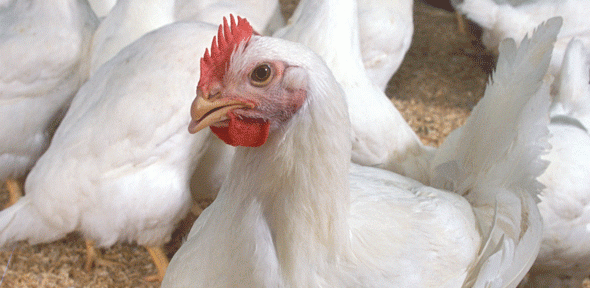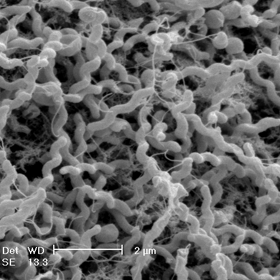
Poultry is an important source of protein; almost half the meat we eat in the UK is chicken. And the popularity of chicken is rising: it’s convenient, tasty and cheap. On average we eat around 190g per person per week. Poultry, however, harbours a hidden problem. Around two-thirds of raw chicken sold by British retailers is infected with bacteria called Campylobacter.
 Campylobacter is ubiquitous in the environment. All chicken flocks, large or small, factory-farmed or free range, are susceptible to infection. The bacteria have the ability to survive the production chain from farm to fork.
Campylobacter is ubiquitous in the environment. All chicken flocks, large or small, factory-farmed or free range, are susceptible to infection. The bacteria have the ability to survive the production chain from farm to fork.
Adequate cooking, however, kills the bacteria and makes chicken safe to eat. Consumers are advised not to wash chicken before cooking and to follow basic hygiene rules when handling raw chicken.
If Campylobacter is ingested by humans, it can lead to diarrhoea. Four out of five cases of food poisoning in the UK can be traced to poultry; sickness from Campylobacter costs the economy an estimated £900 million each year. Recovery can take a week or more, and infection with the bacteria is also associated with serious complications – including reactive arthritis and Guillain-Barré Syndrome.
These facts are the driving force behind research being undertaken by microbiologists Dr Andrew Grant, Professor Duncan Maskell and their groups at the Department of Veterinary Medicine. “Campylobacter is the leading source of bacterial gastroenteritis, affecting half a million people and killing an estimated 100 people each year in the UK,” says Grant. “This is why it’s a major target for research efforts.”
Poultry is big business. Production units supplying the major supermarkets can house 50,000 birds or more. Even when stringent biosecurity measures are taken, incursions occur when barriers are broken. “It takes just a couple of bacteria, or perhaps even one, entering a unit for a flock of thousands of birds to be infected in less than a week,” says Grant. “The chicken gut is the ideal vessel for Campylobacter to flourish. Transmission is guaranteed by a continual process of consumption and excretion known as coprophagy.”
There are no vaccines – either for poultry or humans – to protect against Campylobacter. The ubiquity and resilience of Campylobacter jejuni (the strain that colonises poultry and causes most gastroenteritis in humans) have prompted a government-led push to reduce the level of infection by developing ways in which to contain, and ultimately eliminate, its presence in the nation’s most popular meat.
“We need to look at the problem both on an industry-wide scale and on a microbial scale. The first approach involves working hand-in-hand with producers and processors and the second working in the lab to understand the structure and behaviour of Campylobacter,” says Grant.
“Working with the industry, we’re building a picture of the highly dynamic process of transmission from one bird to another and also at the ways in which Campylobacter is spread during slaughtering and processing. In the lab we’re looking at how we can manipulate Campylobacter so that it can’t spread – essentially we’re trying to identify and target its Achilles heel.”
One avenue being explored is the identification of the Campylobacter genes required for chicken colonisation, which could make good targets for therapeutic intervention. Another approach is to disarm Campylobacter by altering its characteristic shape from spiral to rod-shaped. Once rod shaped it loses its ability to colonise chickens and cause disease in humans.
 Scientists working on Campylobacter face formidable challenges. Highly successful in the environments where it thrives best, the bug is difficult to culture in the lab where scientists need to work with live bacteria.
Scientists working on Campylobacter face formidable challenges. Highly successful in the environments where it thrives best, the bug is difficult to culture in the lab where scientists need to work with live bacteria.
In the food production and retailing sectors, a reluctance to take ownership of the problem has led to lack of investment in measures to address an issue that each sector sees as the other’s problem. The profit margins made by farmers are tiny – as low as one or two pence per bird produced. The onus therefore is seen to lie with processors and retailers to invest in intervention and control strategies.
There is a mounting sense of urgency in the drive to eliminate Campylobacter from the nation’s food chain. Incidents of Campylobacter food poisoning are continuing to rise. Around 75,000 cases per year are ‘culture confirmed’ and, due to under-reporting, the true total is estimated to be equivalent to at least 460,000, and possibly 750,000, cases.
“Campylobacter found in raw chicken sold to consumers is generally on the surface of the birds, which means that adequate cooking quickly destroys the bacteria. But we now think that it might be entering chickens’ muscle tissue and internal organs,” says Grant.
“Infection by Campylobacter is considered to be the most prevalent cause of bacterial diarrhoeal disease worldwide. Compared to many other pathogens we know comparatively little about the bacteria and there are still many more questions than answers. There is a need for alternative strategies to reduce Campylobacter in chickens and Campylobacter-induced disease burden in humans.”
Next in the Cambridge Animal Alphabet: D is for a creature that prowls the Museum of Archaeology and Anthropology, confronts students in the Department of Anglo-Saxon, Norse and Celtic, and was a fertile symbol for medieval poets.
Inset images: Raw chicken in a pot (eltpics); Campylobacter jejuni (Andrew Grant).
The Cambridge Animal Alphabet series celebrates Cambridge's connections with animals through literature, art, science and society. Here, C is for Chicken – a popular source of protein that carries a hidden hazard in the form of Campylobacter.

The text in this work is licensed under a Creative Commons Attribution 4.0 International License. For image use please see separate credits above.